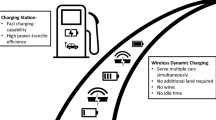Abstract
Distance-based road user charging is being seen as one potential mechanism to implement national road charging schemes. This paper investigates the design aspects of universal distance-based charging schemes and incorporates procedures within a detailed network supply model to represent how a range of different permutations of distance-based charges across a given network (charging regimes) affect route-choice, travel characteristics and demand for road space. The results suggest that distance-based charging can reduce number and length of trips, congestion, accidents and pollution, and provide net economic benefits and revenues. However, these benefits are not found to be uniform throughout the network. Their magnitude largely depends on the charge level, the hierarchy of charges across the network, and the difference between the charge levels.
Similar content being viewed by others
References
Commission of the European Communities CEC (1995). Towards fair and efficient pricing in transport, COM (95) 691, Final. (Green Paper).
Commission for Integrated Transport (CfIT) (2006). World review of road pricing, phase 2 final report. Retrieved 03 March 2007, from https://doi.org/www.cfit.gov.uk/docs/2006/wrrp/wrrp2/pdf/wrrp2-finalreport.pdf.
Commission for Integrated Transport. NERA, Oscar Faber (2002). Paying for road use. Retrieved 5 April 2007, from https://doi.org/www.cfit.gov.uk/docs/2002/pfru/research/pdf/pfru-tech.pdf.
Department for Transport (2004–7). Transport analysis guidance. Units 3.5.2, 3.5.3, 3.5.4. Retrieved August. 6, 2007, from transport analysis guidance ∣ WebTag.
Department for Transport (2004). Feasibility study of road pricing in the UK, a report to the Secretary of State. Retrieved 26 January 2007, from https://doi.org/www.dft.gov.uk/pgr/roads/roadpricing/Feasibilitystudy/studyreport/feasibilitystudyofroadpricin4002.
Department for Transport (2006). National Transport Model. Retrieved 31 February 2007, from https://doi.org/www.dft.gov.uk/pgr/economics/ntm.
Department for Transport (DfT) Highways Economics Note No.1 (HEN1) (2005). Valuation of the benefits of prevention of road accidents and casualties. Retrieved 26 March 2007, from https://doi.org/www.dft.gov.uk/pgr/roadsafety/ea/pdfeconnote105.pdf.
DMRB (2006). Economic assessment of road schemes. The COBA manual, Volume 13, Section 1, (pp 4/1–4/5). Retrieved 7 July 2007, from https://doi.org/www.dft.gov.uk/pgr/economics/software/coba11usermanual/Part2thevalofcostsandb3154.pdf.
Eddington, R. (2006). The Eddington transport study: Transport’s role in sustaining the UK’s productivity and competitiveness, 2 and 3, 78–82. London: The Stationery Office.
Fridstrom, L., Minken, H., Moilanen, P., Shepherd, S., & Vold, A. (2000). Economics and equity effects of marginal cost pricing in transport: Case studies from three European cities. Helsinki: Government Institute for Economic Research.
Glaister, S., & Graham, D. J. (2005). An evaluation of national road user charging in England. Transportation Research Part A, 39, 632–650.
Glaister, S., & Graham, D. (2006). National road pricing: Is it fair and practical? Imperial College London. London: The Social Market Foundation.
Hensher, D. A., & Puckett, S. M. (2006). Congestion and variable user charging as an effective travel demand management instrument. Transportation Research Part A, 41, 615–626. doi:https://doi.org/10.1016/j.tra.2006.07.002.
HFA (1993). Road pricing in London: Review and specification of model elasticities. Section, 7, 96–112. Final report submitted to Department of Transport.
Treasury, H. M. (2007). Appraising the options. Green Book: Appraisal and evaluation in central government. Chapter 5. Retrieved 6 August 2007, from https://doi.org/greenbook.treasury.gov.uk/chapter05.htm.
Knight, F. (1924). Some fallacies in the interpretation of social cost. The Quarterly Journal of Economics, 38, 582–606. doi:https://doi.org/10.2307/1884592.
Leeds City Council (2004). Traffic monitoring report: Executive summary. Leeds: Leeds City Council.
May, A. D., & Milne, D. S. (2003) The impact on network performance of drivers’ response to alternative road pricing schemes. In Santos, G. (Ed.), (2004) Research in transportation economics Vol. 9(3). Oxford: Elsevier Science & Technology.
MVA, The Denvil Coombe Practice, Atkins, David Simmonds Consultancy, Environmental Resources Management, Kellogg Brown & Root and WSP (2004). Road Pricing Feasibility Study: Composite Report Tests Using Multi-Modal Study Models: South and West Yorkshire (SWYMMS) London Orbital (ORBIT) Cambridge to Huntingdon (CHUMMS). Prepared for the Highways Agency, UK.
National Statistics.DfT (2004) Transport statistics bulletin traffic in Great Britain q4. Retrieved 10 July 2007, from https://doi.org/www.dft.gov.uk/162259/162469/221412/221546/224925/224965/224973/225439/trafficingreatbritainquarter5405.
Pigou, A. C. (1920). Wealth and welfare. London: MacMillan.
Rouwendal, J., & Verhoef, E. T. (2006). Basic economic principles of road pricing: From theory to application. Transport Policy, 13, 106–114. doi:https://doi.org/10.1016/j.tranpol.2005.11.007.
Smeed, R. (1964). Road pricing: The economic and technical possibilities. The Smeed report. London: UK Ministry of Transport, HMSO.
Symonds, T. (2006). ‘What would road pricing cost?’ BBC news, 16 October. Retrieved 3 April 2007, from https://doi.org/news.bbc.co.uk/go/pr/fr/-/1/hi/uk/6055128.stm.
Tsekeris, T., & Voss, S. (2009). Design and evaluation of road pricing: State-of-the-art and methodological advances. NETNOMICS: Economic Research and Electronic Networking. doi:https://doi.org/10.1007/s11066-008-9024-z.
Webster, B. (2007). Road pricing: The plan. Times (London), 2 March, p 1.
Author information
Authors and Affiliations
Corresponding author
Rights and permissions
About this article
Cite this article
Balwani, A., Singh, S. Network impacts of distance-based road user charging. Netnomics 10, 53–75 (2009). https://doi.org/10.1007/s11066-008-9025-y
Received:
Accepted:
Published:
Issue Date:
DOI: https://doi.org/10.1007/s11066-008-9025-y




